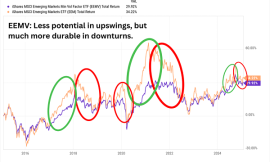With the S&P 500 sitting at all-time highs right now, many market participants are feeling ebullient.
However, for those who are still building wealth and deploying new money, it’s tough to buy stocks now.
Or is it?
While the S&P 500 is punching new records, there are many stocks within it that are nowhere near record highs.
The market isn’t a monolith; it’s a market of stocks, not necessarily a stock market.
And that’s a great thing, as it opens up opportunities for those willing to sift through the names.
A good filter to make that sifting easier?
The Dividend Champions, Contenders, and Challengers list.
This list has put together invaluable information on hundreds of US-listed stocks that have raised dividends each year for at least the last five consecutive years.
This is an important distinction, as it means that the stocks on the list qualify for the dividend growth investing strategy.
This is a long-term investment strategy which involves buying and holding shares in world-class businesses that are so adept at growing profits that they’re able to reward shareholders with steadily rising cash dividends (which get funded by the rising profits).
This powerful strategy, by its very nature, almost automatically funnels investors right into some of the world’s best businesses, stocks, and investments.
I’ve been using this strategy for 15 years, allowing it to guide me as I’ve gone about building the FIRE Fund.
That’s my real-money portfolio, and it generates enough five-figure passive dividend income for me to live off of.
Actually, I’ve been in the very fortunate position of being able to live off of this dividend income since I quit my job and tried out retirement in my early 30s.
If you’re wondering how such an early retirement is possible for regular people like us, make sure to read my Early Retirement Blueprint.
Circling back around to what I said at the outset of today’s article, there are many high-quality dividend growth stocks that are nowhere near 52-week highs.
This is awesome news that ties right into the critical concept of valuation.
See, price is only what you pay, but value is what you get.
An undervalued dividend growth stock should provide a higher yield, greater long-term total return potential, and reduced risk.
This is relative to what the same stock might otherwise provide if it were fairly valued or overvalued.
Price and yield are inversely correlated. All else equal, a lower price will result in a higher yield.
That higher yield correlates to greater long-term total return potential.
This is because total return is simply the total income earned from an investment – capital gain plus investment income – over a period of time.
Prospective investment income is boosted by the higher yield.
But capital gain is also given a possible boost via the “upside” between a lower price paid and higher estimated intrinsic value.
And that’s on top of whatever capital gain would ordinarily come about as a quality company naturally becomes worth more over time.
These dynamics should reduce risk.
Undervaluation introduces a margin of safety.
This is a “buffer” that protects the investor against unforeseen issues that could detrimentally lessen a company’s fair value.
It’s protection against the possible downside.
Treating the stock market as a market of stocks, not a monolith, gives an investor the ability to find those terrific opportunities among the undervalued high-quality dividend growth stocks out there.
Of course, finding those opportunities requires the investor to already have at least a basic understanding of valuation in place.
If that’s not in place for you, no worries.
In that case, give fellow contributor Dave Van Knapp’s Lesson 11: Valuation a read.
Part of a series of “lessons” designed to “teach” dividend growth investing, it’s an excellent resource that lays out the ins and outs of valuation using simple terminology.
With all of this in mind, let’s take a look at a high-quality dividend growth stock that appears to be undervalued right now…
S&P Global Inc. (SPGI)
S&P Global Inc. (SPGI) is a US-based leading provider of credit ratings, benchmarks, analytics, and workflow solutions to various markets worldwide.
Founded in 1860, S&P Global is now a $159 billion (by market cap) financial markets behemoth that employs more than 40,000 people.
Approximately 60% of the company’s revenue is derived from the US.
The company reports results across five segments: Market Intelligence, 32% of FY 2024 revenue; Ratings, 30%; Commodity Insights, 15%; Mobility (which is being spun out over the next 12 to 18 months), 11%; and Indices, 11%.
One could think of S&P Global as three terrific businesses all in one: S&P Global has a scaled-up intelligence business with high-value proprietary data, it controls the largest ratings agency in the world, and it owns an irreplaceable indices business that has the various S&P products (such as the S&P 500, the global gold standard) under its umbrella.
Each business on its own could make for a very appealing long-term investment; all three being being combined into one package makes this one of the most unique and compelling long-term investment opportunities out there.
In a data-driven world where information is treasured for its valuable insight, S&P Global has a treasure trove with unparalleled scale.
Its credit ratings business has a nigh-impenetrable economic moat (companies issuing public debt are practically required to have a rating) and operates within a comfortable oligopoly (there are only three major ratings agencies which combine to control almost 100% of the global market).
The indices it owns have numerous revenue drivers (such as subscription fees, asset-linked fees, and transaction royalties) and are embedded within global capital markets in a way that would be nearly impossible to change/eliminate/displace.
We’re talking about world-class barriers to entry, “sticky” products, network effects, and IP here.
If you look up “wide economic moat” in the dictionary, a picture of S&P Global must be there (I’m kidding, kind of).
It’s difficult to imagine a future world 25 years from now in which this company is any less large, successful, or profitable.
To the contrary, its numerous levers to pull just about guarantee above-average growth across its revenue, profit, and dividend well into the future, just as it’s been for years already.
Dividend Growth, Growth Rate, Payout Ratio and Yield
To this point, S&P Global has increased its dividend for 52 consecutive years.
Yes, this is a Dividend King.
It’s also part of the vaunted S&P 500 Dividend Aristocrats index (an S&P Global product… wink-wink).
In terms of dividend growth consistency, there are few who have done it better than S&P Global.
Its 10-year dividend growth rate of 11.7% is strong, although dividend raises in recent years have been in a mid-single-digit range (in order to give the company breathing room as it digests major acquisitions designed to strengthen its firm grip over global markets even more).
And with a payout ratio of 30.2%, the company’s dividend looks to be as secure as ever (and that’s saying something, as it’s been steadily growing for more than half a century).
The one drawback to the dividend profile is the yield.
At only 0.7%, there’s plenty to be desired, especially for income-sensitive investors.
However, this yield is pretty much in line with the stock’s own five-year average.
Said another way, this stock typically has lots of demand from buyers who are more than willing to accept this level of yield.
By the way, over the last five years, the stock is up by ~60%, so buying it in spite of the uninspiring starting yield hasn’t been a bad call at all.
Besides, the dividend raises should allow long-term holders to grow their way into respectable income over time.
For those who do have that kind of longer-term investment horizon, S&P Global has been, and almost certainly will remain, a fantastic investment.
Revenue and Earnings Growth
As fantastic as it might be, though, these dividend measures are largely looking backward.
However, investors must always have a forward-looking mindset, as the capital of today ultimately gets risked for the rewards of tomorrow.
Thus, I’ll now build out a forward-looking growth trajectory for the business, which will be of great assistance when the time comes to estimate fair value.
I’ll first show you what the business has done over the last decade in terms of its top-line and bottom-line growth.
And I’ll then reveal a professional prognostication for near-term profit growth.
Blending the proven past with a future forecast in this manner should give us what we need to formulate an idea of where the business could be going from here.
S&P Global advanced its revenue from $5.3 billion in FY 2015 to $14.2 billion in FY 2024.
That’s a compound annual growth rate of 11.6%.
Superb top-line growth, particularly when considering how large and mature S&P Global already was a decade ago.
But this is a misleading figure.
S&P Global acquired IHS Markit, an information services provider, in 2022 for $44 billion, greatly expanding the company’s data offerings.
This move, which more vertically integrated the firm and added more recurring revenue, created what could be described as a capital markets empire.
It also created about 50% more revenue for S&P Global instantly, so the top-line growth rate has been far from completely organic.
Meantime, earnings per share jumped from $4.21 to $12.35 over this period, which is a CAGR of 12.7%.
The excess bottom-line growth comes in spite of a far higher (~14%) outstanding share count (the IHS Markit transaction was an all-stock deal), giving us early signs of some accretion.
Because of the size of the IHS Markit deal (the largest acquisition ever for S&P Global), the jury is still out on how prudent the capital allocation here truly was.
However, even if the deal is only middling in terms of its success, S&P Global is so large and dominant that it can actually afford that kind of modest success with a giant move.
I wouldn’t want management to make a habit out of it, and there’s nothing yet pointing to that kind of outcome, but I’m only pointing out that the sheer might of this company affords management some margin of safety when it comes to capital allocation.
Looking forward, CFRA is anticipating a 15% CAGR for S&P Global’s EPS over the next three years.
Talk about accretion.
That’s some serious growth out of a large, mature, established, dominant firm.
CFRA highlights synergy (evidenced by margin expansion) from the IHS Markit deal as a near-term tailwind offsetting some softness in the Ratings segment.
Regarding that last point, lower deal flow and IPOs over the last few years have limited new opportunities for the rating agencies, but this is almost certainly going to reverse course over the next few years as capital unlocks, exits occur, and new companies become public.
CFRA also notes S&P Global’s revenue diversity and strong history of durability, as well as a shift to passive investing playing right into the company’s ownership of major indices, as key reasons to be enthusiastic.
The shift to passive vehicles is secular in nature, and S&P Global’s positioning as the world’s largest provider of indices means the company disproportionately benefits from this shift.
To put CFRA’s forecast into perspective, S&P Global’s most recent quarter showed 12% YOY growth.
Regardless of the exact precision of CFRA’s forecast, we’re directionally looking at low-teens to mid-teens bottom-line growth out of S&P Global, which would set the dividend up for like (or better) growth.
This would be even better than the demonstrated dividend growth out of the company over the last decade.
Some acceleration in growth off of what is already a very nice base would be excellent, and I think this would be even more impressive in light of S&P Global’s existing track record being so long already.
I mean, an acceleration of dividend growth off of 11%+ when it’s more than 50 years into the game is simply remarkable.
Combining low-teens growth with the starting yield puts one in a position to earn a mid-teens type of annualized total return out of the stock over the coming years.
That would not be herculean at all for S&P Global, as the stock has compounded at nearly 20% annually over the last decade.
This is a high-quality compounder to the nth degree.
Financial Position
Moving over to the balance sheet, S&P Global has a great financial position.
The long-term debt/equity ratio is 0.3, while the interest coverage ratio is nearly 20.
There has been some minor deterioration of the balance sheet over the last few years, but there is still immense financial strength here.
Profitability is usually extremely robust, but the IHS Markit acquisition is causing temporary fluctuations.
Return on equity has averaged 149.4% over the last five years, while net margin has averaged 29%.
ROIC has historically trended around the 50% mark, which is just incredible, although, again, the last few years have shown an unusual lumpiness.
There appears to be some profitability dilution after recent acquisitions, but this broadening out into more recurring revenue across interconnected verticals has made the company even more resilient and predictable.
It’s hard to overstate how impressive S&P Global is.
And with economies of scale, network effects, barriers to entry, “sticky” products already firmly embedded into global markets, IP, and R&D, the company does benefit from durable competitive advantages.
Of course, there are risks to consider.
Litigation, regulation, and competition are omnipresent risks in every industry.
S&P Global is somewhat insulated from competition, as it operates (or even dominates) within oligopolistic markets.
In addition, because of the regulatory hurdles involves in the global financial markets, along with the way in which S&P Global is so entrenched already, regulation is, arguably, as much of a shield as it is a risk for S&P Global.
The company’s massive trove of data could become less useful and valuable as AI-powered research becomes ubiquitous, although AI is trained on data.
IHS Markit was S&P Global’s largest acquisition ever, and there are unanswered questions regarding just how synergistic and beneficial the deal was, along with whether or not the price paid was appropriate.
The number of public companies has been decreasing for years, reducing opportunities for listings and ratings, but deal flow appears to be picking up after a lull.
Being a global enterprise, S&P Global does face geopolitics and currency exchange rates; however its lack of physical infrastructure and the embedded nature of its financial products does protect the firm from most geopolitical storms.
Overall, I see the risk profile for S&P Global as being relatively low.
Combining a low-risk profile with a high-quality quotient adds up to a terrific long-term investment that deserves a premium, but the stock’s current premium doesn’t seem to fully reflect the nature of the business…
Valuation
The P/E ratio of 41.3 is far from low.
While this stock is never optically cheap, nor should it be, the current P/E ratio is blurred by the digestion of IHT Markit.
Looking at midpoint guidance for this year’s adjusted EPS, the forward P/E ratio drops to 30.9, which is not egregious at all for a world-class business of this stature.
Keep in mind, the stock’s own five-year average P/E ratio is nearly 40, so this is a stock that usually commands (and deservedly so) a healthy premium.
Notably, the P/CF ratio of 29.6 is slightly lower than its own five-year average of 30.5.
And the yield, as noted earlier, is roughly in line with its own recent historical average.
So the stock looks cheap when looking at basic valuation metrics. But how cheap might it be? What would a rational estimate of intrinsic value look like?
I valued shares using a two-stage dividend discount model analysis.
I factored in a 10% discount rate, a 25-year dividend growth rate of 13%, and a long-term dividend growth rate of 8% thereafter.
Because of the low yield and high growth rate over an extended period of time, this is a tough stock to put into a DDM analysis.
Nonetheless, what I’m doing is roughly splitting the difference between the demonstrated 10-year dividend growth rate and the near-term forecast for E’PS growth, and then I’m extrapolating that well into the future, after which I’m assuming a slowdown of growth into a HSD range.
S&P Global used to be known as McGraw-Hill Companies, Inc., which was also involved in textbooks, and its storied history incorporates this prior composition.
But transformational changes over the last decade have totally remade the company.
Looking at S&P Global today, it has one of the most impressive operations in the whole world, simultaneously running three high-margin businesses each with wide economic moats.
It’s better than it’s ever been; yet, it’s been amazing.
To think the future is better than the past is hard to wrap one’s mind around, but that’s what we could be staring at.
Thus, modeling in a slight acceleration in dividend growth, relative to the last decade, isn’t crazy, nor is modeling that out for quite a while into the future, as S&P Global’s integrated, high-margin, moat-y businesses are built to thrive indefinitely.
The DDM analysis gives me a fair value of $545.10.
The reason I use a dividend discount model analysis is because a business is ultimately equal to the sum of all the future cash flow it can provide.
The DDM analysis is a tailored version of the discounted cash flow model analysis, as it simply substitutes dividends and dividend growth for cash flow and growth.
It then discounts those future dividends back to the present day, to account for the time value of money since a dollar tomorrow is not worth the same amount as a dollar today.
I find it to be a fairly accurate way to value dividend growth stocks.
In my view, while this is not an inexpensive stock, it’s also not quite as expensive as it ought to be.
But we’ll now compare that valuation with where two professional stock analysis firms have come out at.
This adds balance, depth, and perspective to our conclusion.
Morningstar, a leading and well-respected stock analysis firm, rates stocks on a 5-star system.
1 star would mean a stock is substantially overvalued; 5 stars would mean a stock is substantially undervalued. 3 stars would indicate roughly fair value.
Morningstar rates SPGI as a 3-star stock, with a fair value estimate of $540.00.
CFRA is another professional analysis firm, and I like to compare my valuation opinion to theirs to see if I’m out of line.
They similarly rate stocks on a 1-5 star scale, with 1 star meaning a stock is a strong sell and 5 stars meaning a stock is a strong buy. 3 stars is a hold.
CFRA rates SPGI as a 3-star “HOLD”, with a 12-month target price of $520.00.
We are all in the same ballpark this time around. Averaging the three numbers out gives us a final valuation of $535.03, which would indicate the stock is possibly 2% undervalued.
Bottom line: S&P Global Inc. (SPGI) is a very high-quality company that generates gobs of growth, fat margins, and high returns on capital. It runs three world-class businesses simultaneously – each one of which is independently a world-class, high-margin, moat-y business. With a respectable yield, a low payout ratio, double-digit dividend growth, more than 50 consecutive years of dividend raises, and the potential that shares are 2% undervalued, long-term dividend growth investors who believe in paying up for quality should take a close look at this Dividend King.
-Jason Fieber
Note from D&I: How safe is SPGI’s dividend? We ran the stock through Simply Safe Dividends, and as we go to press, its Dividend Safety Score is 99. Dividend Safety Scores range from 0 to 100. A score of 50 is average, 75 or higher is excellent, and 25 or lower is weak. With this in mind, SPGI’s dividend appears Very Safe with a very unlikely risk of being cut. Learn more about Dividend Safety Scores here.
P.S. If you’d like access to my entire six-figure dividend growth stock portfolio, as well as stock trades I make with my own money, I’ve made all of that available exclusively through Patreon.
Disclosure: I have no position in SPGI.



